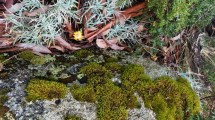Summary
-
1.
A system is described in which a behavioral test is used to match color shades to an arbitrarily chosen level to the compound of brightness and saturation. This system was used with honeybees (Apis mellifera carnica) to develop a series of color marks which were equal to the compound of brightness and color saturation to bees.
-
2.
Freely flying honeybees were trained to a blue color mark on a vertical screen. Discrimination of this blue color from violet, green, blue-green and yellow was tested at various natural luminances. In the majority of the experiments the background screen was painted achromatic grey of the same luminosity as the color marks. Two training procedures were used: one utilized a feeding station, the other the hive entrance.
-
3.
Bees discriminate colors best at luminances between 101 and 102 cd/m2. Color discrimination is less acute at both higher and lower luminance levels; these deficits at high and low luminances have been termed the bright light and dim light effects, respectively. Color discrimination disappears below 10−1 cd/m2 (Fig. 6). The dependence of color discrimination on available light is the same in both the violet and blue-green regions.
-
4.
It is concluded that bees have achromatic vision at low light levels (<10−1 cd/m2), and that they can use this achromatic vision during extreme low light situations — even during flight orientation. The bright light effect is discussed with respect to results from single unit electrophysiological recording experiments and appears to result from the specific behavior of light adaptation in the retinula cell — monopolar cell system. The narrow luminance band of optimum color discrimination suggests that color discrimination may be better than previously determined using selfruminant spectral lights (von Heiversen 1972a).
Similar content being viewed by others
References
Autrum H, Zwehl V von (1964) Spektrale Empfindlichkeit einzelner Sehzellen des Bienenauges. Z Vergl Physiol 48:357–384
Barlow HB (1952) The size of ommatidia in apposition eyes. J Exp Biol 79:667–674
Daumer K (1956) Reizmetrische Untersuchungen des Farbensehens der Bienen. Z Vergl Physiol 38:413–478
Erber J, Menzel R (1977) Visual interneurons in the median protocerebrum of the bee. J Comp Physiol 121:65–77
Hamdorf K (1979) The physiology of invertebrate visual pigments. In: Autrum H (ed) Handbook of sensory physiology, vol VII/ 6A. Springer, Berlin Heidelberg New York, pp 145–224
Helversen O von (1972a) Zur spektralen Unterschiedempfindlichkeit der Honigbiene. J Comp Physiol 80:439–472
Helversen O von (1972b) The relationship between difference Stimuli and choice frequency in training experiments with the honeybee. In: Wehner R (ed) Information processing in the visual systems of arthropods. Springer, Berlin Heidelberg New York, pp 323–334
Hertel H (1980) Chromatic properties of identified interneurons in the optic lobes of the bee. J Comp Physiol 137:215–231
Kien J, Menzel R (1977a) Chromatic properties of interneurons in the bee optic lobes. I. Broad band neurons. J Comp Physiol 113:17–34
Kien J, Menzel R (1977b) Chromatic properties of interneurons in the bee optic lobes. II. Narrow Band and Colour Opponent Neurons. J Comp Physiol 113:35–53
Kirschfeld K (1974) The absolute sensitivity of lens and compound eyes. Z Naturforsch 29c:592–596
Laughlin SB, Hardie RC (1978) Common strategies for light adaptation in the peripheral visual systems of fly and dragonfly. J Comp Physiol 128:319–340
Menzel R (1974) Spectral sensitivity of monopolar cells in the bee lamina. J Comp Physiol 93:337–346
Menzel R (1975) Electrophysiological evidence for different color receptor in one ommatidium of the bee eye. Z Naturforsch 30c:692–694
Menzel R (1977) Color vision in insects. Verh Dtsch Zool Ges 70 Jahresv 26–40
Menzel R (1981) Achromatic vision in the honeybee at low light intensities. J Comp Physiol 141:389–393
Menzel R, Blakers M (1976) Color receptors in the bee eye: morphology and spectral sensitivity. J Comp Physiol 108:11–33
Menzel R, Snyder AW (1978) Photorezeptor Optik: Struktur und Funktion von Photorezeptoren. In: Hoppe W, Lohmann W, Markl H, Ziegler H (Hrsg) Biophysik, ein Lehrbuch. Springer, Berlin Heidelberg New York, S 468–481
Ribi WA (1975) The first optic ganglion of the bee. I. Correlation between visual cell types and their terminals in the lamina and medulla. Cell Tissue Res 165:103–112
Schlecht P (1979) Colour discrimination in dim light: an analysis of the photoreceptor arrangement in the mothDeilephila. J. Comp Physiol 129:257–267
Snyder AW (1977) Acuity of compound eyes: physical limitations and design. J Comp Physiol 116:161–182
Snyder AW, Stavenga DG, Laughlin SB (1977) Spatial information capacity of compound eyes. J Comp Physiol 116:183–207
Author information
Authors and Affiliations
Additional information
Supported by an NS&B Scholarship to Marine Biological Laboratory, Woods Hole, DAAD Grant 315/4-usa-4-sk and a Luft-Brückendank Stipendium
Recipient of a Rand Professorship to Woods Hole. Additional support provided by a grant from the DFG
The authors thank David Schessel, Johannes Menzel, Ute Kindermann and Gabriela Koske for their help in performing these experiments; Dr. D.R. Stokes and E. Lieke for their helpful criticism of this work; and J.H. Reynolds and B. Cwienczek for their careful
Rights and permissions
About this article
Cite this article
Rose, R., Menzel, R. Luminance dependence of pigment color discrimination in bees. J. Comp. Physiol. 141, 379–388 (1981). https://doi.org/10.1007/BF00609940
Accepted:
Issue Date:
DOI: https://doi.org/10.1007/BF00609940




